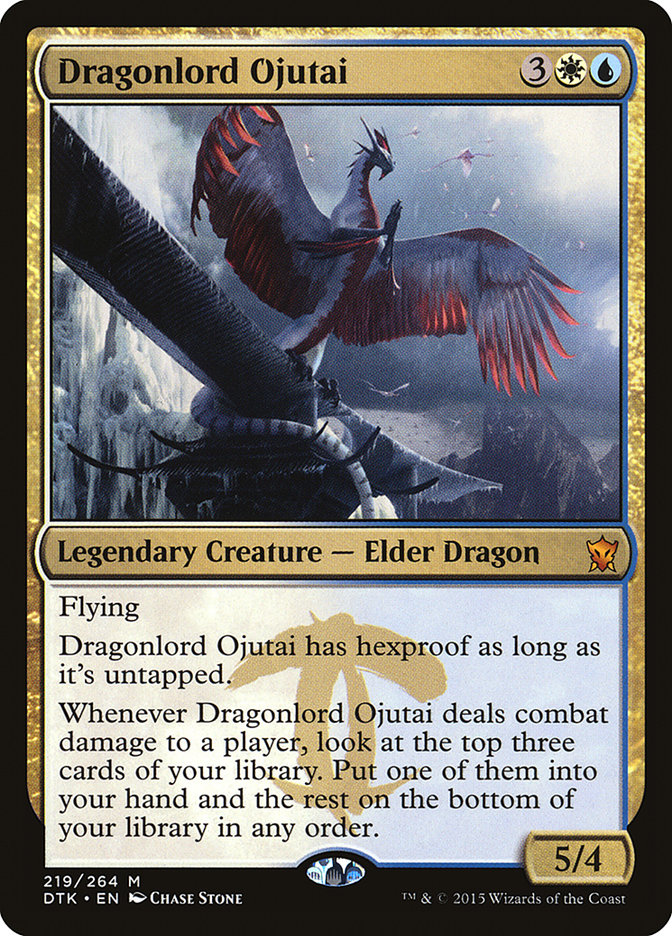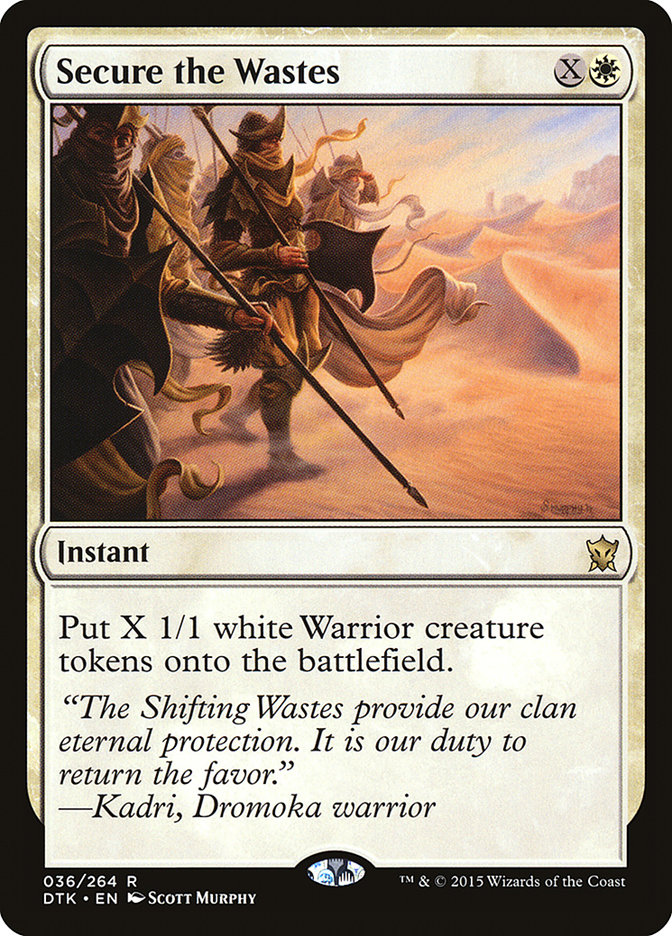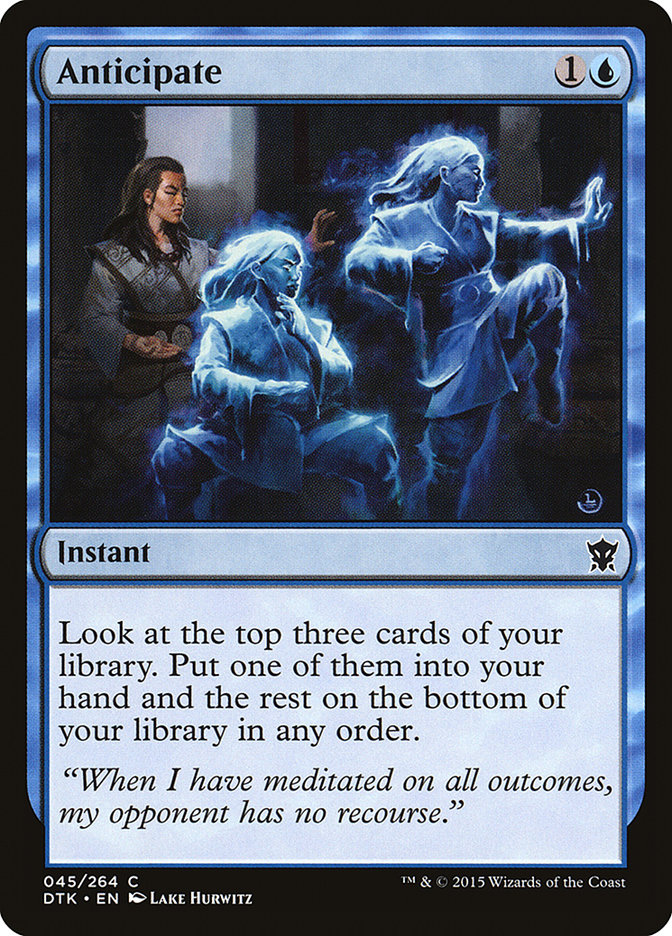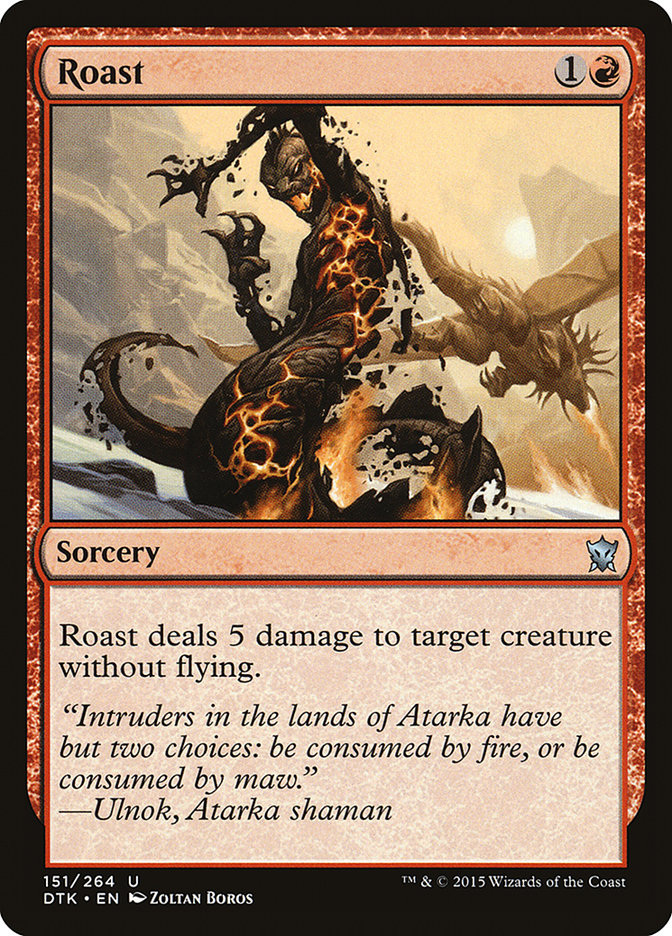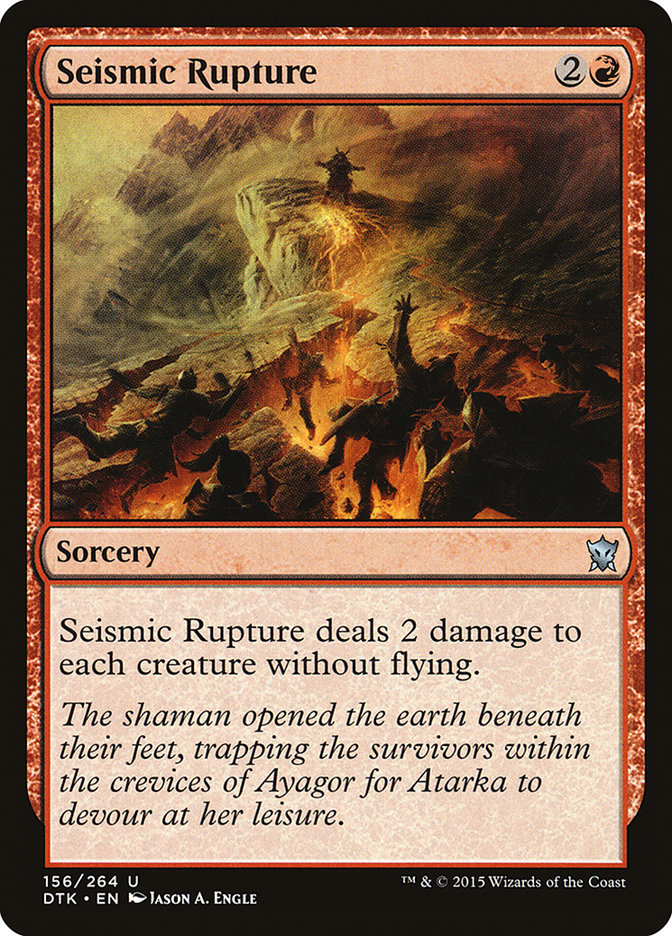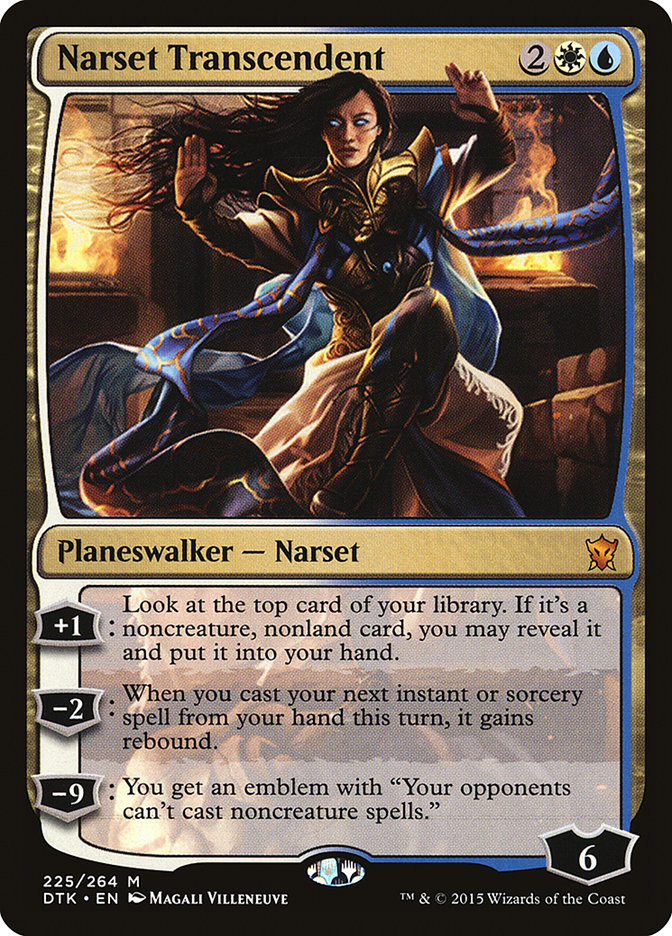“Trust your gut.”
It is a difficult thing to change someone’s mind who is utterly convinced that they are right. When you work with someone like Brad Nelson, Brian
Braun-Duin, or Tom Ross, changing their mind on a subject that they are quite familiar with is nearly impossible. That isn’t to say that these guys aren’t
right most of the time. They are great players and deckbuilders, and listening to them is generally a good bet.
But listening to yourself is important too.
At times, I am lost when it comes to the format(s) I am testing for. In those scenarios, I lean on my friends when they have something solid. But there are
other times when we’re all working on something, but we can’t really come to the same conclusions because we didn’t have enough time to work everything
out. This past weekend at the Season One Invitational was one of those times.
We had been testing for about two weeks leading up to the tournament, trying out all of the new cards from Dragons of Tarkir in various brews, as well as
established decks. I am admittedly weak at building decks based around new cards, and most of them end up looking like someone built it with a cookie
cutter. The aggro decks are one-dimensional, while the control decks are full of significant holes. And even still, the midrange decks aren’t even playing
the best win conditions. It is infuriating, sifting through cards and just not seeing what makes everything work. But when I see an idea that looks solid
on paper, I get to work.
With the Season One Invitational featuring Dragons of Tarkir Standard, it was the first look at the new format, and most people didn’t get to test enough
with the new cards if they got to test any at all. There are a lot of powerful cards in the new set, and I was excited to see if we had nailed the format
down. At this tournament, we expected very few new decks. We assumed that most players would opt for the safe route, just playing older archetypes they
were comfortable with but with few of the new cards.
That meant we could build our deck to expect a reasonable amount of the following archetypes:
R/W Aggro
Jeskai Aggro
Abzan Control
Sultai Control
Mono-Red Aggro
G/W Devotion
With that in mind, we looked at how the new cards could fit into existing archetypes. The best thing we found was Anticipate in Jeskai Tokens since it was
an excellent way to dig for your copies of Jeskai Ascendancy or just hit your land drops in the earlygame. It also helped facilitate an easy switch between
an aggro deck and a control deck after sideboard since it plays well with counterspells.
As you can probably tell from the VS Video series, we’ve tried a lot of different stuff over the last few weeks. Dragonlord Atarka felt pretty powerful but
a bit too slow in the matchups where it would normally shine. Sarkhan Unbroken was similarly strong, but I’m not sure if it is better or worse than the
older version. Roast ended up being a bit worse than any of us initially thought but still a fine answer to Siege Rhino and a few other annoying green
creatures.
But Brad came through once again, writing a pretty sweet article a few weeks
ago featuring updated decks with Dragons of Tarkir, and the one that stood out to me the most was Jeskai Tokens. So that’s where we started.
Creatures (7)
Lands (24)
Spells (29)

The first thing I thought when looking at the deck was that Soulfire Grand Master seemed out of place. Sure, it is a powerful card that works well with
burn spells, gaining a lot of life while also threatening to gain a lot of card advantage later in the game. In actuality, Soulfire Grand Master is a
luxury that this deck can’t afford. You have plenty of things to do with your mana most of the time, so Seeker of the Way seems like a much better fit for
the deck. It is a much more aggressive creature that gains about the same amount of life in the long run, but it deals more damage on average. The fact
that you can also protect it from an opposing Drown in Sorrow is the tipping point for me.
The thing about this deck that I loved the most was playing games after sideboard. Anticipate let you move effortlessly between switching to a much more
controlling role in a matchup where it was warranted. You could play draw-go a lot more often when you were sitting on Disdainful Stroke and a number of
other removal spells. You could also sideboard into a deck with a lot of threats that didn’t line up well with the removal spells that most people would
bring in. Planeswalkers and bigger creatures could be fairly problematic for the opponent, but everything changed once we cast Dragonlord Ojutai for the
first time.
I can’t even begin to describe the feelings associated with attacking with Dragonlord Ojutai with a Jeskai Ascendancy in play. While testing with the new
Ojutai, we found that it was pretty difficult to lose a game where you he hit the opponent just a single time. A big swing in damage and a free (usually
great) card was great, but the fact that it could be insanely difficult to kill thanks to Jeskai Ascendancy was a big bonus.
Rabblemaster was still Rabblemaster, and it gave us a lot of free wins, so it stayed in the deck. Hordeling Outburst continued to shine alongside Jeskai
Ascendancy and Stoke the Flames, so the only real thing to figure out after that was the removal package. Wild Slash seemed solid against all of the other
Rabblemaster decks, and it was a cheap spell to trigger Jeskai Ascendancy when you needed it. But Valorous Stance didn’t seem like it was doing enough, and
Brad felt like we would get pummeled by the Mantis Rider decks. Lightning Strike is a reasonable card, but I just don’t know if it is actually necessary
anymore. It is worse than Wild Slash in the matchups where either would be good, and I don’t want to overload on that kind of a spell because it can
quickly become a dead card against a Siege Rhino deck.
So I hedged. I wanted a Roast to complement the Valorous Stance to give me a few ways to attack their bigger creatures while still giving me a number of
cheap ways to interact with early threats from the opponent. I also thought that we needed to diversify our threats a bit in the sideboard, as it is
dangerous to lean heavily on a single type of card in an unknown format. To that end, I wanted Elspeth, Sun’s Champion. I’ve always wanted Elspeth. It has
always been insane in this style of deck because it is so versatile and so inherently powerful. It beats Drown in Sorrow. It beats Siege Rhino and Tasigur
and even Sidisi, Undead Vizier.
But I couldn’t convince anyone else to play it.
The night before the tournament, I thought long and hard about how many of the matchups would play out and which cards I could sideboard to help implement
that strategy. I sat for probably twenty minutes just trying to figure out if I wanted to play a second Roast over the Lightning Strike.
Oh, and also Legacy.
After a week and change of talking about the formats and testing a bit, here’s what I ended up playing:
Creatures (7)
Lands (24)
Spells (29)

Creatures (12)
Lands (20)
Spells (28)

The new Standard format didn’t look like it changed all that much on the surface. A few decks got upgraded a bit, but there aren’t any new archetypes
running around…yet. I think that Dragons of Tarkir will end up having a significant impact on the format, and I can’t wait for the Pro Tour to showcase
that for us. With so many inherently powerful cards in the set, I can’t imagine that everything is just going to stay the same.
But for week one, that is what I expected, and that’s exactly what happened. The Top 8 of the Invitational didn’t feature any breakout decks, but it did
give us some new ideas on how to improve existing archetypes. I think the biggest winner for adding new cards is Jeskai Tokens, but I don’t think any of us
have any clue on how to build it right, including me.
The following cards could be considered for the deck, and I wouldn’t bat an eye at anyone who played them.
There are a few others that might warrant a conversation, but I am probably playing everything on that list besides Dragon Fodder at the Open Series in
Syracuse this coming weekend. And that says a lot about a new set when there are five or more playables for a single archetype that already exists. While
few of these cards are game-changers, there are some heavy hitters among them that don’t attack the opponent on the same axis as the rest of your deck.
When you’re staring down Drown in Sorrow and Bile Blight, how will the opponent feel when you slam a Dragonlord Ojutai? What about Narset Transcendent when
they board out all of their Hero’s Downfalls? What about when they tap out for some big threat, only to have you Secure the Wastes for six or seven, then
kill them on the spot with Jeskai Ascendancy?
There are a lot of new cards that could potentially see play in the archetype, but we chose the above list because it is what we tested, and it was safe.
For a tournament the size of the Invitational, and with so many potential new cards coming into the format, it isn’t possible to see everything. We had to
assume that most people would be on one of the decks I listed above, or at least something similar, and build our deck accordingly. Goblin Rabblemaster is
a huge part of this deck because it is one of the easiest ways to win the game alongside a draw that doesn’t feature Jeskai Ascendancy. When coupled with
removal, Goblin Rabblemaster is the best threat in the format.
But as people start to understand how to beat a deck like Jeskai Tokens, boarding in cards that are specifically troublesome, that’s when you have to find
a new way to fight back. And that’s where Ojutai and the rest of the gang comes in. Having cards that dwarf their removal is key because it isn’t all that
hard to find ways to kill all of your creatures. They are quite small, after all.
But what about when they start killing your Jeskai Ascendancy too? What about when they’re hitting you with a ton of discard effects while doing all the
other things listed above? Well, then you have a tough game on your hands, and you’ll want as many powerful cards in your deck as you can fit and still
have it run smoothly. This is where Anticipate comes in. Anticipate allows you to play fewer copies of all the cards you want to draw in the lategame
because you can eventually find them if you have enough time. With so much removal in the deck, games can tend to go pretty long. If you can stabilize the
board and start casting Treasure Cruise, you should be able to pull pretty far ahead of your opponent both on board and in resources.
As for the tournament itself….
Well, let’s just say that it didn’t start well for me. Day 1 was pretty rough, where I lost a few matches of Legacy due to the Infect deck just flooding
out or being unable to handle certain cards from the opponent, while my loss in Standard was because I missed my third land drop in both games. After a
thrilling match in Round 8 playing for Day 2, I barely squeaked it out on the back of Become Immense on my Glistener Elf when we were both in topdeck mode.
I went to sleep on Friday night before Day 2 of play with the full intent of dropping from the Invitational if I took a loss in the first three rounds.
Even though I could still win money with a loss, the most I could win was $750, and I would rather have a shot at winning the Standard Open. While my
mindset wasn’t exactly perfect for the second day of competition, I wasn’t giving up hope. I talked to a few friends and told them what I planned to do,
and none of them really had any objections. After all, going 8-0 on Day 2 was mostly a pipe dream.
With very little sleep and a lot of Magic ahead of me, I started Day 2 without breakfast or high expectations. The good news is that I was fully prepared
to take things one match at a time, which is a great place to be when you’re in a tournament. Keeping focused on what matters here and now is how you make
sure you don’t get too far ahead of yourself. If you start worrying about “what record makes Top 8” or “how many more wins do I need to cash,” then you’ll
lose sight of the big picture. That is one of the reasons why so many people make their first Top 8 of a tournament and then immediately lose. Most people
are happy with Top 8, and when you are content then you don’t care as much if you lose.
And so the long journey began. I had to win eight matches in a row to make Top 8 and three more from there to win the whole shebang. A new token with my
face on it and $10,000 is a pretty sweet prize, if I say so myself. But I was looking back over my shoulder every time I sat down for a match, checking to
see what round the Standard Open was in. Making sure that I still had time to drop and join should I lose.
But the loss never came.
And I kept winning, round after round, knocking each and every one of my opponents out of Top 8 contention. I was the executioner, and hot damn did it feel
good. I was slaughtering Abzan Control and Jeskai mirrors left and right with no remorse. Dragonlord Ojutai was well fed, and my Jeskai Ascendancy always
found Treasure Cruise when I needed it most. But after Standard came the hard part.
Legacy is normally the easy part of these tournaments for me. But something about Infect has changed over the last few months. At first, Tom Ross would
beat just about everyone with the deck because they didn’t know how to play against it. Even some of the best players in the game were completely vexed,
and Tom’s aura at the table certainly doesn’t help. If you’ve ever played against him, you’ll know what I’m talking about. The way he sits up when he draws
a card, how he mutters to himself so that you’re always wondering if he’s counting up the damage to kill you, or if he’s just singing a song to himself. No
one knows.
But over time, other people started to pick up Infect, including Brad Nelson and myself. The more we played it, the worse it got, because people eventually
started to learn how to beat it. People eventually started playing hate cards for it. And ultimately, I don’t know if it is actually good enough anymore.
You’ll still get a few free wins here and there because people don’t know what’s going on, but it will only get harder as the archetype continues to pick
up in popularity. The deck is still solid, and I could see a few changes here and there to make it better, but it is only a matter of time before I move on
to something different.
On Day 1 of the tournament, that is exactly how I felt. Deflated, demoralized, and just ready for the killing blow to come. But after rattling off a 4-0 in
Standard, I had a chance. All I needed was to sweep Legacy, my bread and butter, to make it into the Top 8. My first challenge would come from Andrew
Schneider, three time Legacy Open champion with his trusty U/R Delver. After some close games, I was able to beat an active Grim Lavamancer to take the
match.
Three more to go.
My next two matches felt pretty easy for a change. Not a ton of disruption, no combos, and then I found myself in a win and in against Jeff Hoogland
playing Reanimator.
Camera time.
I sat down against Jeff and didn’t exactly know what he was playing, which is a bit awkward. But I keep an opener that seemed pretty reasonable and we
began.
Spoiler alert: Grafdigger’s Cage is pretty good against Reanimator.
So here I am, exploding with excitement after making my first Invitational Top 8 in over two years. The emotion was overwhelming as I finally got to hear
my name announced over the loudspeaker again. It was such an absurd juxtaposition of emotion, going from razor’s edge across the finish line and into the
Top 8.
Unfortunately, the run ends here. After rattling off nine wins in a row, I was finally defeated by Jason Coleman and Abzan Aggro. His creatures lined up
well with my removal spells, and his Dromoka’s Charms were stellar against basically all parts of my deck. Jason played well, and he deserved the win after
a major sideboarding error on my part.
But for the first time in a while, I’m happy with how I finished even though I didn’t win the tournament. It took quite a bit of luck and reasonable play
to make it as far as I did, and it felt great to finally have something to show for a lot of the hard work I’ve been putting in recently. In all honesty, I
could always play more, test more, and research more, but you have to find the time for you. Without a bit of rest and relaxation, no amount of testing is
going to help you.
But we’re not done just yet. This weekend, the Open Series comes to Syracuse for some Standard action! I am more than likely playing Jeskai Tokens in some
capacity, though I haven’t had quite enough time to test out the ideas that I wanted to try. But here is what I want to try next.
Creatures (5)
Planeswalkers (1)
Lands (25)
Spells (29)

This version of Jeskai Tokens is a bit slower, though it is harder to disrupt. I think it is much stronger against other aggressive decks because it isn’t
trying to play the Goblin Rabblemaster game, which gets hosed pretty hard by opposing Wild Slashes. I like the way this deck looks on paper and will be
testing it in preparation for this coming weekend.
Even though I made Top 8 of the Invitational, I’m not even close to being in the race for the Players’ Championship. I have a lot of work to do if I want
to catch up, and I don’t plan on missing out again.

